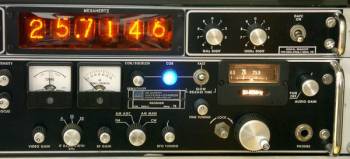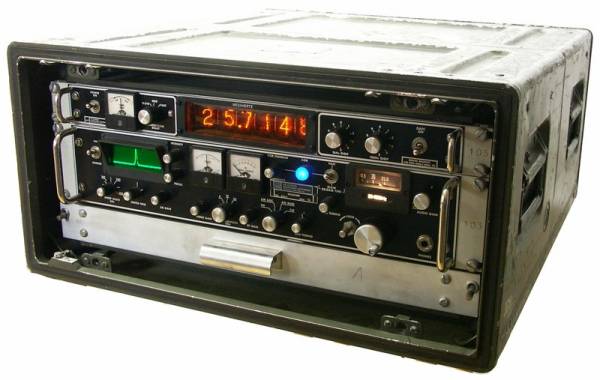Inhaltsverzeichnis
E-649: Watkins-Johnson WJ-521A-3
E-649, Surveillance Receiver Watkins-Johnson WJ-521A-3; manufactured by Watkins-Johnson, Gaithersburg, Maryland, U.S..
The surveillance receiver Watkins - Johnson WJ-521A-3 with the optional digital frequency display DRO-290 A1 has been used by the „Funkpolizei“, the military radiocommunications traffic surveillance, to monitor traffic on the military used VHF bands, it got the military designation E-649.
Technical Data
- Frequency range: 20 - 80 MHz
- Analog dial, digital display DRO-290, max. 100 Hz
Power Supply
- Mains: 220 V
Dimensions
- 90 + 45 x 483 x 478 mm; 8.2 kg
- in the cabinet: 270 x 534 x 682 mm; 36 kg
Accessories
Operation
The VHF surveillance receiver Watkins Johnson WJ-521A-3 has been presented to the public in 1967 and it saw use at the military radio traffic surveillance („Air police“) under the designation E-649.
The receiver WJ-521A-3 itself together with the digital frequency display DRO-290-A1 and the DAFC option, a high stability frequency synthesizer, has been installed in an aluminum case. In an accessories drawer, the headphones, necessary cables and a logbook can be stored.
The left part of the frontpanel is taken by a panoramic display offering an visual survey on all R.F. emissions in a certain frequency segment. You can select the SWEEP WIDTH, the width of the band segment displayed up to 300 kHz, adjust the SM GAIN, the level of the signals displayed and move the most interesting signal in the middle of the display using the CENTER FREQ control.
The controls of the receiver itself are located on the right half of the frontpanel: At the right, just above the headphones jack, you find the AUDIO GAIN volume control combined with the mains switch, at it's left the main tuning knob. The receiver is equipped with a mechanical film dial with coarse frequency markings, you can also read the reception frequency from the nixie tubes frequency display, the option DRO-290-A1 is installed in all Swiss receivers. Of the two analog meters, one is used as signal strength meter and the second one as center indicator when the set is set to FM operation.
The modes switch lets you select between CW (A1), AM (A3) and FM (F3) mode, you can control the beat note in CW mode with the BFO control. In the position AM AGC, automatic control and in position AM MAN manual gain control is selected, the R.F. gain control is used to control RF gain in the AM modes. The set comes with three I.F. filters, filters with a bandwidth of 4, 10 and 50 kHz are installed.
 The digital frequency display does indicate the operation frequency with an accuracy of 100 Hz. For high frequency stability, you can activate the DAFC, a high stability frequency synthesizer for the 1 kHz and 100 Hz digits of the desired reception frequency.
The digital frequency display does indicate the operation frequency with an accuracy of 100 Hz. For high frequency stability, you can activate the DAFC, a high stability frequency synthesizer for the 1 kHz and 100 Hz digits of the desired reception frequency.
Technical Principle
The WJ-521A is a double conversion superhet, the incoming signal from the antenna is amplified and converted to the first IF of 10 MHz in the first mixer stage.
After the first IF amplifier Q+ with FET transistors, the signal has to pass a 50 kHz crystal filter, is amp0lified in the second IF amplifier stage Q2 and mixed with the 10.455 kHz vom oscillator Q3 to be converted to the 2nf IF of 455 kHz. For the IF bandwidths 4 and 10 MHz, the signal has to pass another crystal filter, is amplified again (Q12, Q13 and 14) and fed to the demodulators.
For demodulation of frequency modulated signals, a solid state limiter and discrimator is used. The audio signal is amplified in two preamlifier and a final amplifier AF stage.
For the panoramic display, the 10 MHz IF signal is used: After a conversion to 2 MHz with the signal of a sweep oscillator, the signal is again mixed with a 2,205 MHz signal, to generate the 205 kHz signal to drive the vertical deflection plate.
Semiconductor setup
The set is solid state.
Development
Watkins-Johnson has developed the WJ-521A-3 in around 1967.



